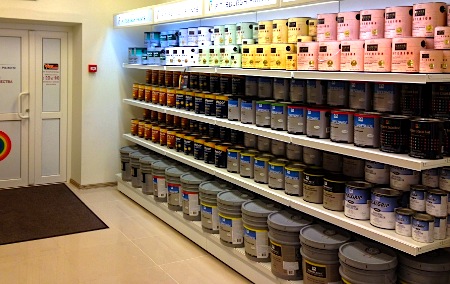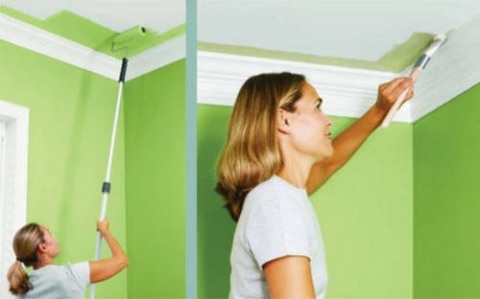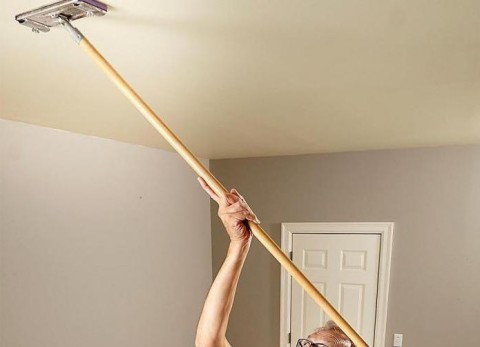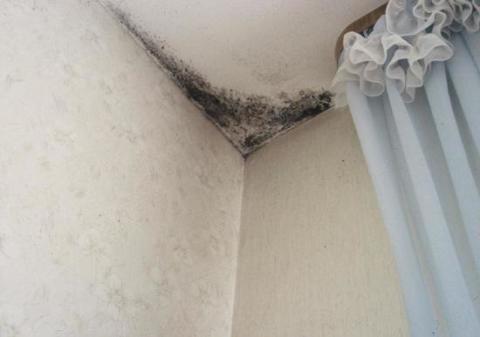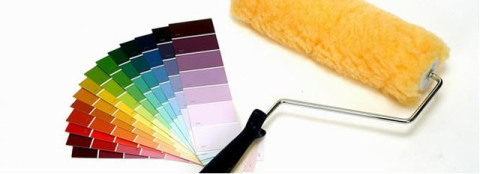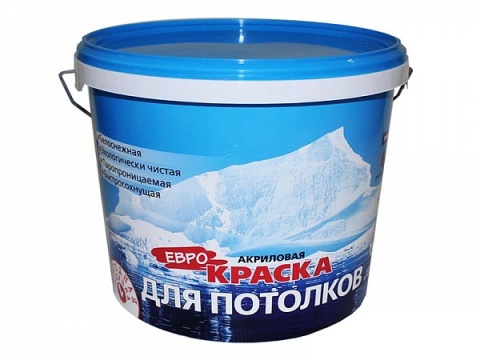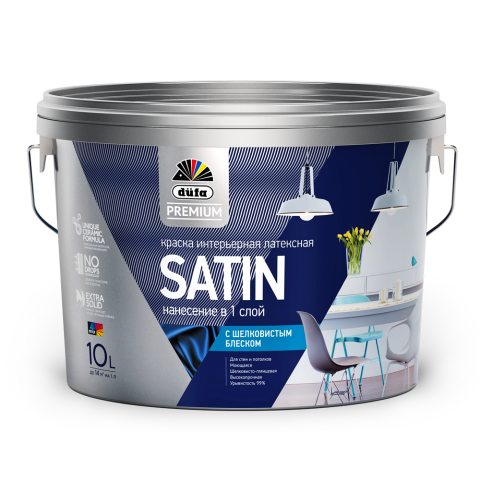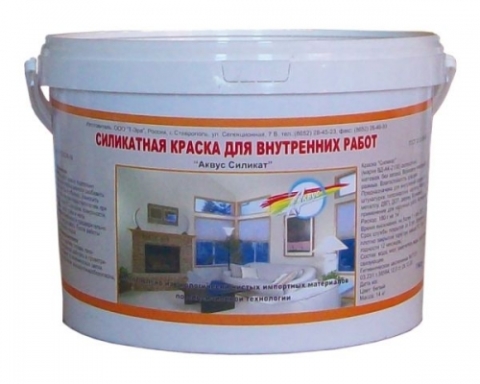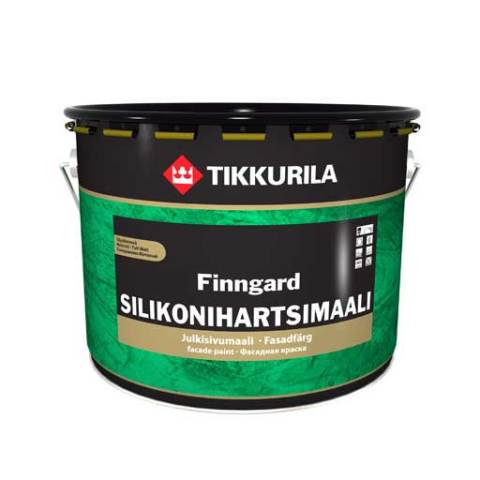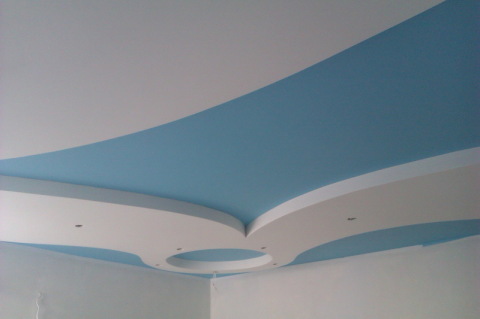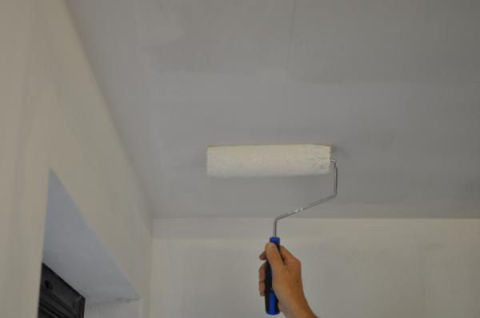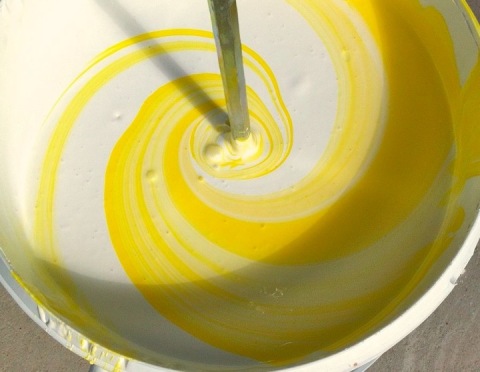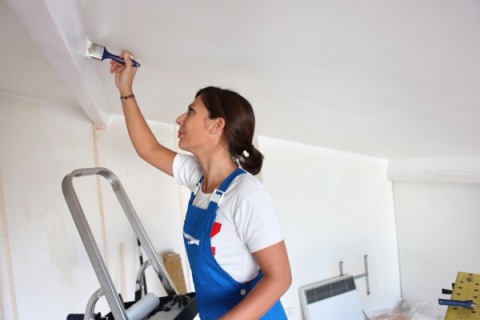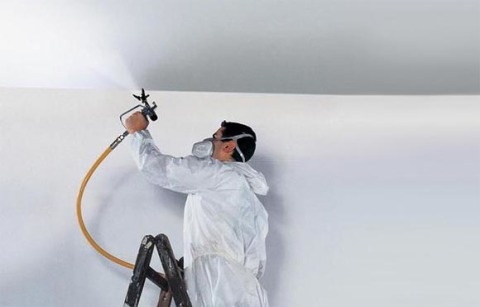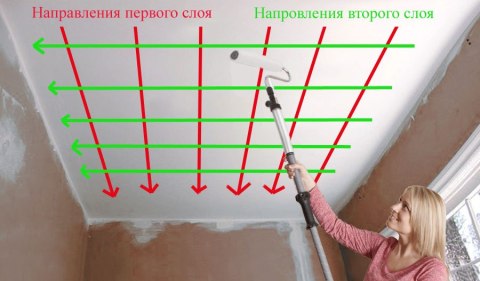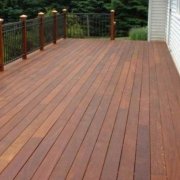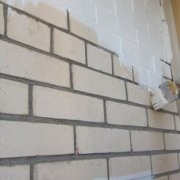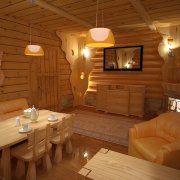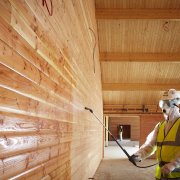Ceiling water-based paint - how and which one to choose
The beautiful ceiling in the apartment plays the same important role in the interior as the floor or walls, so when repairing or decorating it needs to be paid no less attention. Today we will talk about the most common material that is most often used for finishing work - this is a water-based paint for the ceiling and give advice on which water-based paint is better to choose.
The content of the article
Differences in water-based paint
What is a water emulsion? In scientific terms, an emulsion is a dispersed system containing a mixture of microscopic drops of two insoluble liquids, such as water and a polymer.
A water emulsion is also called water dispersion paint, since it is based on aqueous dispersions of polymers (polyacrylates, polyvinyl acetates and others) containing suspensions of pigments, fillers, as well as special additives of various auxiliary substances (emulsifiers, stabilizers, etc.). There are no organic solvents in the paint, so it is non-toxic and completely safe for health.
In addition, depending on the type of paint and the presence of these same additives, it has some undoubted advantages over other types:
- Fire and explosion safety.
- Resistance to hostile environment, in particular, to alkalis.
- Low abrasion resistance.
- Moisture resistance (some types of paint can be washed repeatedly with detergents).
- Long service life.
- Gas and vapor permeability.
- Resistance to adverse weather factors.
- Good hiding power.
- Compatible with almost all surfaces.
- Ease of application.
- Affordable price.
Of the shortcomings, it should be noted:
- Exposure to bacteria, mold, fungus, which especially reproduce on paint in a damp or poorly heated room. But some types of material contain antibacterial and antifungal additives that solve this problem.
- Cracks at low temperature.
- Unsuitable for coloring adhesive, varnished and metal coatings.
Important! If you still really need to paint the metal, then after applying a couple of primer layers to it, the water emulsion will perfectly cover this surface.
Types of water-based paint
Manufacturers produce several types of "water emulsion". Technical characteristics, places of application, performance and cost of the material depend precisely on those additives. Let's try to figure out what a water-based paint for the ceiling is, to choose the most suitable in composition and quality.
So, the market offers the following types of water-dispersion paint:
- Polyvinyl Acetate.
- Acrylic
- Latex.
- Silicate.
- Silicone
We will tell about each separately.
Polyvinyl Acetate Emulsion
In its composition, the paint contains the following components:
- Polyvinyl acetate emulsion (homogeneous thick white liquid), which is used for the manufacture of PVA glue.It can be of two types: plasticized, afraid of freezing temperatures and freezing at 0 degrees; not plasticized, not losing its operational qualities during fourfold freezing and thawing.
- Stabilizers.
- Colorful pigments (may or may not be present).
- Plasticizers.
Paint is made in accordance with GOST 28196 89. When applied to the surface, water evaporates, and additional substances harden and acquire hydrophobic properties. Drying time - 2-3 hours at a temperature of +22 degrees, the film formed has a homogeneous porous semi-matt structure.
Basically, the ceiling painting with water-based polyvinyl acetate paint is popular because of the following features:
- Lack of harmful components.
- Explosion-proof and fireproof.
- It has good hiding power.
- Suitable for application on porous surfaces (concrete, brick, wood, plaster, cardboard).
- It dries quickly.
- It mixes well with colorants.
- It has good adhesion, lies evenly and beautifully.
- Forms a strong elastic film.
- It has the lowest price among analogues.
We can not say about the disadvantages of polyvinyl acetate paint, they should include:
- Weak water resistance, therefore paint is used only in dry rooms.
- The ability to quickly abrasion under mechanical stress.
- The inability to apply to metal, chalk, lime, alumina or vitriol surfaces. Upon contact with these materials, the paint may peel off, crack and fall off.
Important! When mixing white paint with color, it is recommended to apply at least 2 layers of the composition to the surface to obtain the best effect.
Acrylic water-based paint
It represents the composition of the water-dispersed mixture and polyacrylates as binders. High moisture resistance distinguishes it from a conventional PVA-based water emulsion. The surface can be washed with detergents, and more than once, and, accordingly, used in rooms with high humidity.
In addition to the listed advantages, an acrylic water emulsion also has other positive qualities:
- Convenience of application. You can paint the surface with a brush, roller, spray gun (seeHow to use a spray gun: tips from professionals).
- Elasticity. The water emulsion fits perfectly on the ceiling, the layer is smooth, equally covered, without streaks and gaps.
- UV resistant. The paint does not change the depth and shade of the color even under prolonged exposure to direct sunlight.
- The combination with almost all materials, even with metal, which must first be primed.
- No toxicity and no unpleasant odor.
- Vapor permeability. The applied composition forms a "breathing" surface, capable of passing air, so that microorganisms, fungus and mold do not form under the paint.
- Abrasion resistance. Ceiling covered acrylic paint, will remain presentable for a long time even with annual wet cleaning.
Latex Water Emulsion
Depending on the polymer that is part of the paint, latex serves as an additive for the following types of water emulsions:
- Acrylic.
- Acrylosilicone.
- Acrylic polyvinyl acetate.
- Acrylic butadiene styrene.
The “breathing” ability is created by latex copolymers, which when dried form a special crystalline structure that is not afraid of moisture, so this coating can be washed even with alkaline solutions.
The degree of gloss for the paint is indicated on the package.
In appearance, the latex emulsion may be:
- Strongly matte (SM 0–5).
- Highly glossy (SG 90–100).
- Glossy (G 60–89).
- Matte (M 6-10).
- Semi glossy (PG 30-59).
- Semi matte (MP 11–29).
If we paint the ceiling with water-based latex paint, it is recommended to pay attention to these designations. Depending on the degree of gloss, the ceiling can be made shiny or silky matte, with a fabric effect.
Important! If the ceiling is finished with wallpaper for painting, then a matte water emulsion will especially emphasize the texture and pattern of the paintings, and glossy, on the contrary, will blur the clarity and distract attention from the texture.
Latex aqueous emulsion has all the positive characteristics of water-dispersed paints, an additional advantage is its special strength and resistance to abrasion. The downside is the deterioration in quality at low temperatures, so it is advisable to use it in heated rooms.
Silicate water emulsion
Paint is a dispersion of water, water glass and coloring pigments. It has all the advantages of water-based paints, such as vapor and air permeability, wear resistance, non-toxicity, explosion and fire safety.
Of particular note is the high moisture resistance and durability of the coating. Surfaces painted with silicate water emulsion last 20–25 years without the need for renovation or repair. In addition, special additives ensure the complete absence of fungus, mold and microorganisms.
Silicone water emulsion
At the heart of this paint are silicone resins, which perfectly interact with almost all types of surfaces. If you have not decided which water-based paint to choose for the ceiling, we recommend that you pay attention to silicone.
And there are several reasons for this:
- The paint structure is such that it easily conceals cracks up to 2 mm wide, after the emulsion has dried, the defects are completely invisible, and the surface looks even and smooth.
- The paint perfectly fits on damp or damp ceilings, which is why it is suitable for use in showers, bathrooms (seeIn the bathroom, painting walls: how to do it right), in the kitchens.
- Due to the high vapor permeability, the fungus and mold on it and under it simply do not start, which means that there is no need for antiseptic impregnation.
- The surface covered with silicone water emulsion does not absorb pollution, therefore it practically does not get dirty and does not need frequent cleaning.
- The paint has a good hiding power, sometimes a single thin layer is enough to achieve a smooth, uniform surface.
The cost of water-based paint for this type of ceiling is quite high, but it is covered by high technical and operational characteristics of the material.
Some tips for painting the ceiling
If you decide to paint the ceiling with your own hands, then experts recommend that you follow several basic rules when doing this work:
- In advance, calculate the consumption of water-based paint per 1 m2 of the ceiling and purchase the right amount for the entire area, and 10-15% for unforeseen expenses must be added to the resulting volume. If this is not done, then the subsequently purchased missing paint may appear with a different shade, and you will have to repaint the entire ceiling.
- The surface must be leveled and all visible defects removed (cracks, grooves, tubercles, unevenly applied old paint, etc.), since under a thin layer of water emulsion all the defects will be visible especially clearly.
- The ceiling before painting must be covered with a primer to remove dust (seeHow to primer the ceiling: we understand in stages), reducing paint consumption and improving adhesion with water emulsion.
- Instead of a primer, you can use the same paint, but half diluted with water.
- If tinting is done with your own hands, then you need to cook immediately the entire volume of paint, otherwise you can later not guess with a shade.
- Corners and hard-to-reach spots must first be painted with a brush, moreover with a thin layer, otherwise subsequently the places covered by the brush will differ from the tone of the total area.
- You can paint the ceiling with a roller or spray gun, apply the paint evenly, without smudges, streaks or gaps.
- The ceiling is covered with at least two layers of water emulsion, smears of the first and second layers are applied perpendicular to each other.
Important! The strips of the finish layer are placed in the direction of the light source, this will help to hide possible minor irregularities or unevenness of the coating.
- On any package printed instructions for the use of this type of paint, to obtain a high-quality and durable coating, it must be strictly followed.
Conclusion
We talked about the types of paint, as well as the advantages and disadvantages of each. But to decide which water-based paint is better for the ceiling, you will have to do it yourself, the choice depends on the type of surfaces to be painted, the type of room and your budget. We offer you to see photos and videos in this article in order to finally decide on this issue.
